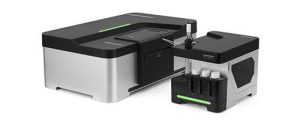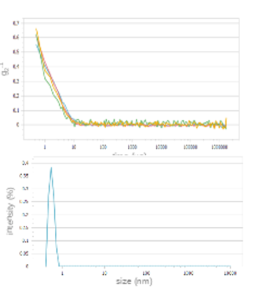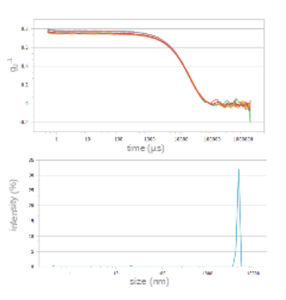BeNano Series Nanoparticle Analyzer
Particle characterization from 0.3 nm to 15 µm in terms of size,
molecular weight and zeta potential by means of DLS, SLS and ELS

The BeNano series is the latest generation of nanoparticle size and zeta potential analyzer. Dynamic light scattering (DLS), electrophoretic light scattering (ELS) and static light scattering (SLS) are integrated in the system to provide accurate measurements on particle size, zeta potential and molecular weight. The BeNano series is widely applied in academic and manufacturing processes of various fields including but not limited to: chemical engineering, pharmaceuticals, food and beverage, inks and pigments, and life science.
Applications
- Colloids, nano metals and metal oxides
- Polymer latices and water/oil emulsion
- Antigens and antibodies
- Pharmaceutical and HPC formulations
- Investigation of temperature-sensitive colloids
- Paints, coating materials, pigments, inks and toners
- Study on polymerization process and reaction mechanism
- Study on kinetics of self-assembly and other processes of macromolecular (de-)polymerization
- Self-assembled micelles, peptides, proteins and biomacromolecules
Features & Benefits
- Determination of Hydrodynamic diameter and its distribution functions, Polydispersity index, Diffusion coefficient, Interaction Parameter, Molecular weight, solution viscosity, Zeta potential and its frequency distribution
- Extended temperature control range: -10 °C – 110 °C +/- 0.1 °C
- Ultra-short measurement times, achieving a result within 2 seconds for a fast scan
- 50 mW Solid-State laser with high beam quality and long service life
- Optical fiber detection system with high sensitivity and improved signal-to-noise ratio
- Avalanche photodiode (APD) detector with high sensitivity for low concentration or weak scattering samples
- Intelligent intensity adjustment and signal judgment system according to signal-to-noise ratio
- Backscattering detection optics for concentrated samples and much higher sensitivity
- Phase Analysis Light Scattering (PALS) for measurement of low electrophoretic mobility and zeta potential
- Various algorithm and adjustable parameters covering scientific research requirements
- Intuitive user interface with multiple languages and free software upgrades

For small particles
The BeNano series is equipped with a 50mW solid-state laser, high-sensitivity APD detector, single-mode fiber detection system and ultra-highspeed multi-mode correlator system, which provides unprecedented sensitivity and lower limit detection range for extremely small particles and fast diffusive samples. Even for molecules smaller than 1 nm such as vitamin B1 (as shown on the right),under very diluted conditions of only 5 %-wt, the BeNano series can effectively detect its scattering intensity and fast decay signals to obtain the particle size and size distribution information.

For large particles
Large particles scatter strongly and one need to avoid multiple scattering effects. On top, they diffuse very slow and easily precipitate. Applying dynamic
light scattering technology for large particles requires controlling the scattering intensity and enough correlation time for the long decay. The high effective detection system of the BeNano series can suppress the multiple light scattering, and a wide correlation time range ensures accurate calculation of slow decay signals. The figure on the right side is the measurement result of a 5 μm polystyrene latex.

Resolution
The resolution of the dynamic light scattering technology depends on the algorithm. Usually for two narrowly distributed components with size difference about three times, the algorithm could achieve two individual peaks by adjusting the resolution to be higher level. The BeNano series provides several algorithms with different resolutions to meet the high-resolution requirements for applications. The figure on the right side is the result of a 60 nm and 200 nm latex mixture.
Repeatability
The BeNano series optical system is robust and stable, combined with automatic intensity adjustment and intelligent signal judgment system, providing extremely high stability and repeatability of measurement results. The figure on the right shows the repeatability of a 60 nm polystyrene latex. It can be seen that the system provides excellent reproducibility with a relative standard deviation of less than 1%.
Zeta potential measurements by ELS
Electrophoretic light scattering (ELS) is a technology for measuring electrophoretic mobility via Doppler shifts of the scattered light. When an incident light illuminates dispersed particles that are subjected to an applied electric field, the frequency of the particles’ scattered light will be different from the incident light due to the Doppler effect. The frequency shift is measured and converted to provide the electrophoretic mobility and hence the zeta potential of a sample by Henry’s equation.
Zeta potential is a key indicator of the stability of the particle system. With a high zeta potential, the repulsive force between particles is strong and the system tends to be stable. Alternatively, with a low zeta potential, the repulsive force between particles is weak, the particles are easy to agglomerate or flocculate, and the system stability is poor. The main factors affecting zeta potential include the dispersant pH, ionic strength (salt concentration) and the concentration of small molecule additives.
Phase analysis light scattering (PALS)
The traditional ELS converts the correlated scattering signals into frequency distribution and then calculates the frequency shift Δf of the scattered light, compared with the reference light. Phase analysis light scattering (PALS), an advanced technology based on the traditional ELS technology, has been further developed to measure zeta potential and its distribution of a sample.
By analyzing the phase information Φ of the original scattered signal, PALS obtains the frequency information of that light. The phase shift dΦ/dt with time is proportional to the frequency shift Δf.
PALS technology can suppress the influence of the Brownian motion of particles on the results, thereby providing higher statistical accuracy. In various applications, PALS can effectively measure the zeta potential of particles whose charge approaches the isoelectric point, for instance, particles with very slow electrophoretic mobility at a high salt concentration.
Molecular weight measurements by SLS
Static light scattering (SLS) is a technology that measures the scattering intensities, weight-average molecular weight (Mw) and second virial coefficient (A2) of the sample through Rayleigh equation. During molecular weight measurements, scattering intensities of the sample at different concentrations are detected. By using the scattering intensity and Rayleigh ratio of a known standard (such as toluene), the Rayleigh ratios of samples at different concentrations are computed and plotted into a Debye plot. The molecular weight and the second virial coefficient are then obtained through the intercept and slope from the linear fitting of the Debye plot.
Specifications
| BeNano 180 Zeta Pro | BeNano 180 Zeta | BeNano 90 Zeta | |
| Measurement principle | DLS + ELS + SLS | ||
| Particle Size Measurement | |||
| Size range | 0.3 nm – 15 µm* | 0.3 nm – 10 µm* | 0.3 nm – 15 µm* |
| Min. sample volume | 3 µl* | 40 µl* | 3 µl* |
| Detection angle | 90° & 173° & 12° | 173° & 12° | 90° & 12° |
| Analysis algorithm | Cumulants, Universal Mode, CONTIN | ||
| Max. concentration | 40% w/v* | Optical clear* | |
| Detection position | Moveable 0 – 5 mm | Fixed 5 mm | |
| Zeta Potential Measurement | |||
| Detection angle | 12° | ||
| Zeta potential range | No limit | ||
| Electrophoretic mobility | > ± 20 µ∙cm/V∙s | ||
| Conductivity range | 0 – 260 mS/cm | ||
| Min. sample volume | 0.75 ml | ||
| Particle size | 2 nm – 110 µm | ||
| Other measurements | |||
| Molecular weight | 342 Da – 2×107 Da* | ||
| Viscosity | 0.01 – 100 cp* | ||
| Interaction parameter kD | No limit | ||
| Trend measurements | Time and temperature | ||
| System Parameters | |||
| Temperature control | -10 – 110 °C +/- 0.1 °C | ||
| Condensation control | Dry air or nitrogen | ||
| Laser source | 50 mW solid-state laser, 671 nm | ||
| Correlator | up to 4000 channels, 1011 linear dynamic range | ||
| Detector | APD (Avalanche photodiode) | ||
| Intensity control | 0.0001 – 100 %, manual or automatic | ||
| Dimensions | 62.5 × 40 × 24.5 cm (L×W×H), 22 kg | ||
| Power supply | AC 100 – 240 V, 50-60 Hz, 4A | ||
| Conformity | ISO 13321, ISO 22412-2017, ISO 13099-1, ISO 13099-2 | ||
*Depending on samples and accessories
For measurements in high concentrations, a 173° detection is demanded, you need: BeNano 180 Zeta
If also a 90° detection for size is desirable, you need: BeNano 180 Zeta Pro
